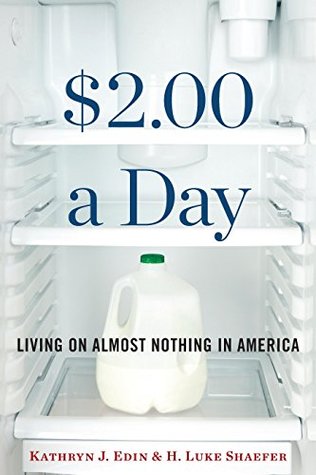More on this book
Community
Kindle Notes & Highlights
Read between
June 14, 2017 - February 9, 2018
Shaefer immediately went to work to see if he could detect a trend in the SIPP data that matched Edin’s observations. First, though, he needed to determine what income threshold would capture people who were experiencing a level of destitution so deep as to be unthought-of in America. Accordingly, he borrowed inspiration from one of the World Bank’s metrics of global poverty in the developing world—$2 per person, per day. At the time, the official poverty line for a family of three in the United States worked out to about $16.50 per person, per day over the course of a year. The government’s
...more
In early 2011, 1.5 million households with roughly 3 million children were surviving on cash incomes of no more than $2 per person, per day in any given month. That’s about one out of every twenty-five families with children in America. What’s more, not only were these figures astoundingly high, but the phenomenon of $2-a-day poverty among households with children had been on the rise since the nation’s landmark welfare reform legislation was passed in 1996—and at a distressingly fast pace. As of 2011, the number of families in $2-a-day poverty had more than doubled in just a decade and a
...more
While single-mother families were most at risk of falling into a spell of extreme destitution, more than a third of the households in $2-a-day poverty were headed by a married couple. And although the rate of growth was highest among African Americans and Hispanics, nearly half of the $2-a-day poor were white.
It was Wilson who first observed, famously, that a poor child fared worse when she grew up among only poor neighbors than she would have if she’d been raised in a neighborhood that included members of the middle class, too.
Out of every one hundred Americans, fewer than two get aid from today’s cash welfare program. Just 27 percent of poor families with children participate. There are more avid postage stamp collectors in the United States than welfare recipients.
At the old welfare program’s height in 1994, it served more than 14.2 million people—4.6 million adults and 9.6 million children. In 2012, the year Modonna took her trip to the DHS office, there were only 4.4 million people left on the rolls—1.1 million adults (about a quarter of whom were working) and 3.3 million kids. That’s a 69 percent decline. By fall 2014, the TANF caseload had fallen to 3.8 million.
In 1960, only about 5 percent of births were to unmarried women, consistent with the two previous decades. But then the percentage began to rise at an astonishing pace, doubling by the early 1970s and nearly doubling again over the next decade. A cascade of criticism blamed welfare for this trend. According to this narrative, supporting unwed mothers with public dollars made them more likely to trade in a husband for the dole. Once again, no credible social scientist has ever found evidence that the sharp rise in nonmarital childbearing was driven by welfare.
And so it was that Ronald Reagan, preparing his run for the presidency during a period when discontent with this stepchild of the welfare state was particularly high, found an issue with broad appeal and seized on it as a way to differentiate himself from his more moderate opponent. His stump speech soon began to feature the “welfare queen”—a villain who was duping the government in a grand style. Unlike the average American, she wasn’t expected to work or marry. The father or fathers of her offspring were given a pass on the responsibility of caring for the children they sired.
The typical AFDC recipient, even in Reagan’s day, was white.
About one in four jobs pays too little to lift a family of four out of poverty.
Service sector employers often engage in practices that middle-class professionals would never accept. They adopt policies that, purposely or not, ensure regular turnover among their low-wage workers, thus cutting the costs that come with a more stable workforce, including guaranteed hours, benefits, raises, promotions, and the like. Whatever can be said about the characteristics of the people who work low-wage jobs, it is also true that the jobs themselves too often set workers up for failure.
Today there is no state in the Union in which a family that is supported by a full-time, minimum-wage worker can afford a two-bedroom apartment at fair market rent without being cost burdened, according to HUD.


